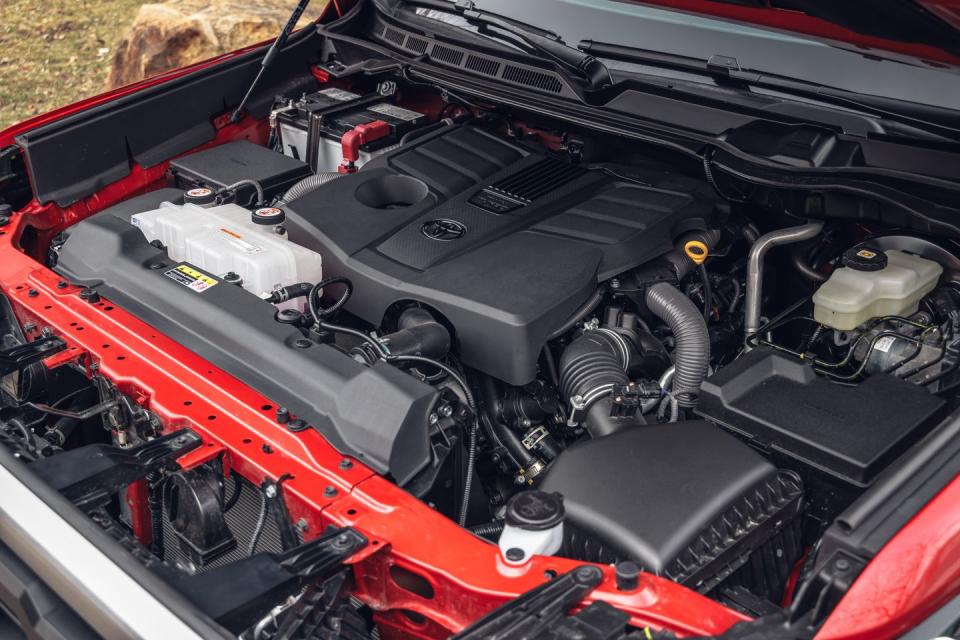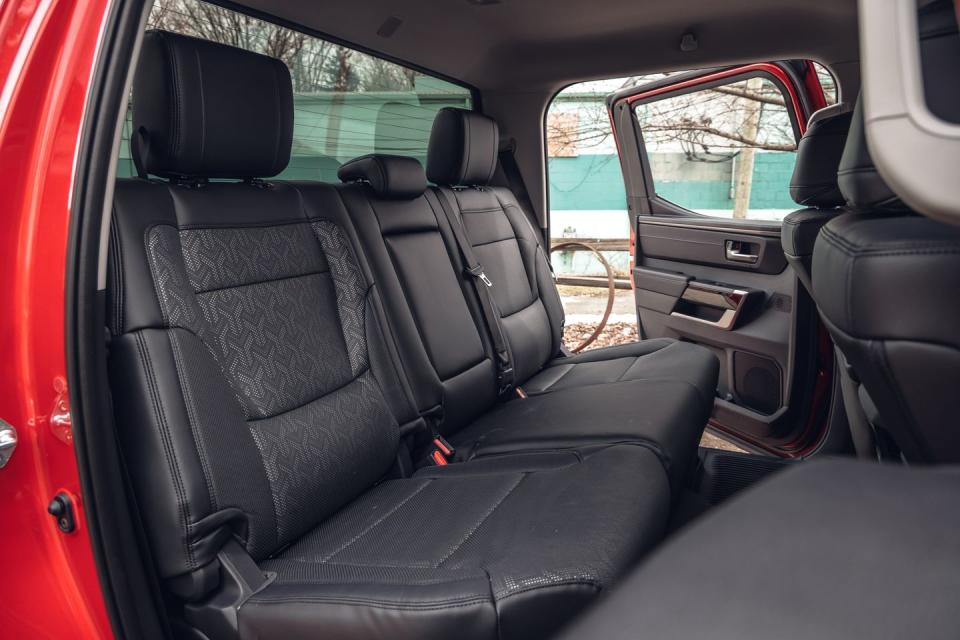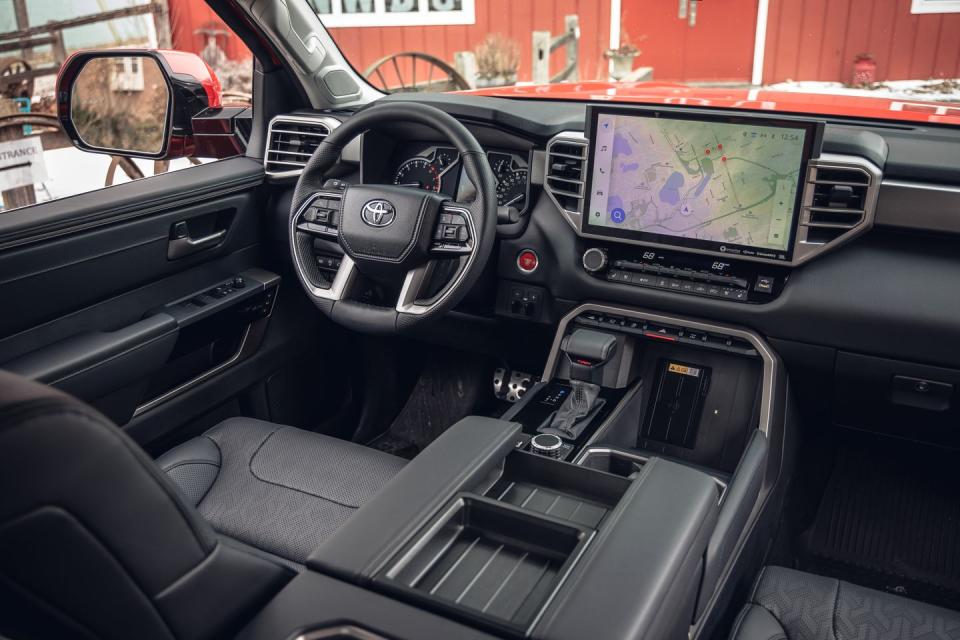Tested: 2022 Toyota Tundra Limited Plays It Safe

Toyota has cultivated a devout fanbase for its trucks over the years, one that tends to value the sturdiness and reliability of the Japanese maker's products over the showy one-upmanship that traditionally defines domestic rigs. Their numbers may be comparatively small, yet enough of these loyalists voted with their wallets over the last 14 years to keep the outgoing Tundra relevant between long-awaited redesigns. For this group, the arrival of the new 2022 Tundra—with its available 437-hp hybrid powertrain, rear air springs, and massive touchscreen—is cause for celebration. Many of them probably won't mind that it merely catches Toyota up with the rest of the full-size truck segment.
Despite its advancements, the new Tundra is a tougher sell when you move down its model lineup. Our mid-grade Limited test truck—four-wheel drive, crew cab, 5.5-foot cargo bed—was 251 pounds lighter than the top-spec TRD Pro hybrid that we previously tested. But at 5856 pounds, it's still several hundred pounds heavier than similarly outfitted rivals from Ford, General Motors, and Ram. Propelled by a standard twin-turbo 3.4-liter V-6 good for 389 horsepower, our test truck reached 60 mph in a modest 6.1 seconds, putting it 0.4 second behind the TRD Pro. Though the Limited catches up by the quarter-mile mark, posting the same 14.5-second time, that pace puts the Tundra toward the back of the current full-size pack. We've clocked a V-8-powered Ram 1500 crew cab at 6.0 seconds to 60 mph, while speedier variants from Ford and GM can reach into the low-five-second range.

Although not the quickest, this volume Tundra model feels quick enough, producing a pleasantly throaty—if synthesized—growl while surfing a 479-lb-ft wave of torque that peaks at just 2400 rpm. A 5900-rpm redline indicates that Toyota's boosted V-6 is not designed for high revs, yet that's fine by the standard 10-speed automatic transmission, which slurs its ratios with impressive smoothness. Unfortunately, we averaged just 14 mpg during our test, and the unimpressive 19 mpg on our 75-mph highway route is 3 mpg below its EPA estimate. We also recorded a relatively noisy 76 decibels inside the cabin at full throttle, but at least the Limited's 66 decibels at 70 mph make it about as quiet while cruising as its peers.

In terms of roadholding, our test truck's 0.73 g of grip and 185-foot stop from 70 mph are adequate but hardly standout efforts. Its brake pedal is firm and progressive, and its steering has a precise, well-calibrated action. The standard all-coil-spring suspension—load-leveling rear air springs are a $650 option—returns a decent if heavy-footed ride on broken pavement when rolling on 20-inch Falken Wildpeak all-terrain tires. That rubber comes as part of the $3085 TRD Off-Road package, which also brings an upgraded suspension with Bilstein dampers and several other extras, including an electronically locking rear differential. Drivers who want an automatic way to deal with slippery conditions are out of luck, though, as the Tundra's part-time four-wheel-drive transfer case does not feature the full-time all-wheel-drive setting that other brands offer. As equipped, our truck was rated to tow up to 11,120 pounds and carry up to 1740 pounds in its aluminum-reinforced composite bed. Again, solid figures but not class leading.

Unlike the Ram 1500, which exhibits an almost carlike level of refinement, the Tundra never lets you forget it's a pickup. Committed truck folk likely won't be bothered by the chunkiness of its controls, the faint quivers that the solid rear axle sometimes sends up through the frame, or how its body can wallow around corners, feeling slightly underdamped. But Toyota has managed the neat trick of making the Tundra seem smaller than it is, despite it having similar proportions to other half-ton trucks. Your five-foot-11 author could reach over the sides of the cargo box without straining, and the cab's 23.9-inch stepover height made it easy to slide behind the wheel, no climbing required. The view out front is appropriately scenic without towering over surrounding traffic. Maybe we've just spent too much time in our towering Ram 1500 TRX long-termer, but this Toyota feels rather wieldy for something 233.6 inches long.

However, there's nothing illusory about its smaller interior dimensions, particularly in back. Compared to the domestic offerings, the crew-cab Toyota's rear-seat space is a couple inches narrower, and its 41.6 inches of rear legroom is as much as several inches shorter—it's also about an inch less than you got in the previous-gen model. Overall, the Tundra's cabin is highlighted by excellent ergonomics and a straightforward design, including our truck's simple analog gauges flanking an intuitive 4.2-inch display; a vibrant 12.3-inch digital cluster is standard on higher trims. It's all very sensible and attractive enough. The easy-to-use 14.0-inch infotainment touchscreen is a welcome upgrade over the standard 8.0-inch unit, although the display's icons and fonts look comically large, and the annoying lack of a dedicated tuning knob is a trap Toyota's designers failed to avoid.
At $60,188, our workaday Tundra's as-tested price still leaves a lot of available equipment on the table. Still, it's a huge improvement over its predecessor. While it's easy to knock the new Tundra for not raising the bar in this cutthroat competitive segment, Toyota truck fans should find it the competent evolution they've long waited for.

You Might Also Like

 Yahoo Autos
Yahoo Autos 